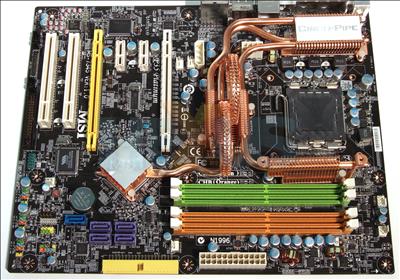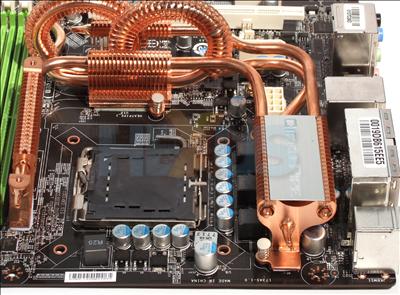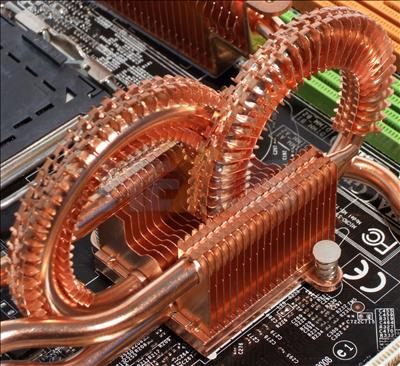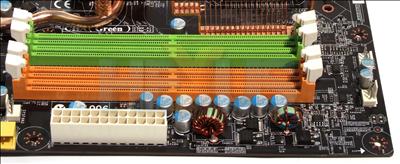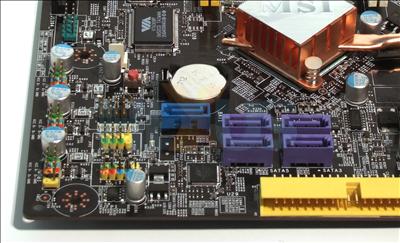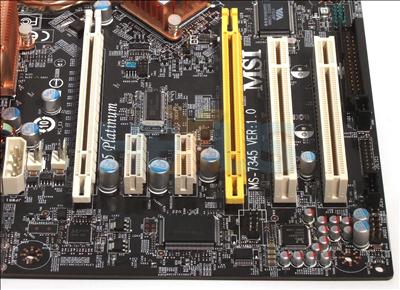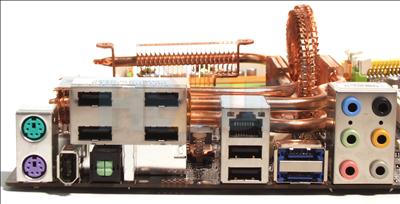Layout musings
The attention-grabbing cooling, dubbed Circu-Pipe, dominates the centre of the ATX motherboard.
MSI has increased the surface area of the heatpipe by adding in a couple of circular sections just above the P35 northbridge. The heatpipe then continues around to the VRMs and then runs back towards the DIMM slots.
The bridge-covering heatpipe, which runs from the ICH9R, does a good job of keeping the underlying ICs cool.
Depending upon the design of your CPU heatsink and the vertical height of the Circu-Pipe, we reckon that the HSF's fan could provide additional cooling to the rollercoaster-esque heatpipe.
Much like most motherboard manufacturers pushing high-end boards, MSI uses solid capacitors for increased reliability.
Back to the exciting bit, here's a closer look at MSI's novel cooling. The two circular sections exit out of a traditional-looking finned heatsink. However, on closer examination we found that the heatpipe in closest proximity to the DDR2 slots actually impinges upon the restriction zone around the LGA775 socket, designed to ensure that decent heatsinks fit without problems.
Our testing highlighted that an Akasa AK-961 wouldn't fit correctly without fouling the Circu-Pipe setup, we noted.
4 slots, 8GiB in total (OS-permitting) and speeds of up to DDR2-1333 provide plenty of bandwidth should you wish to overclock the CPU's FSB.
Looking towards the southbridge area, we like the fact that MSI has an onboard clear-CMOS button in a readily-accessible location. We also like the location of the angled PATA port, right at the edge of the board.
Just below the red button are useful, but tiny, LEDs that can help diagnose problems during the POST sequence by flashing in various states. Cross-check these against the manual and you'll know if it's a memory- or CPU-related failure. The obvious downside is needing to peer inside your case should you need access to said LEDs.
We're informed that retail boards will have an 'OC' jumper which should force certain FSBs - 333MHz, for example - irrespective of the CPU used.
Moving on around the VIA FireWire ASIC and looking at the expansion slots, we see the yellow-coloured x4 electrical slot that can be used as either a CrossFire-forming slot or for adding in additional video outputs via another PCIe card. You will effectively block off access to the (Marvell-powered) blue-coloured SATA2 port should an extra-long graphics card be used, and MSI doesn't supply any right-angled SATA cables that would alleviate the problem.
There's sufficient width between the primary x16 PCIe slot and second x1 for a double-width card not to block off access. The six-slot arrangement is such, though, that the location of the main x16 slot, high up on the board, makes it difficult to remove and install system memory without having to spend onerous time grappling with your graphics card.
A standard-looking I/O section that's marked out by having a couple of eSATA ports that are run off the ICH9R southbridge.






